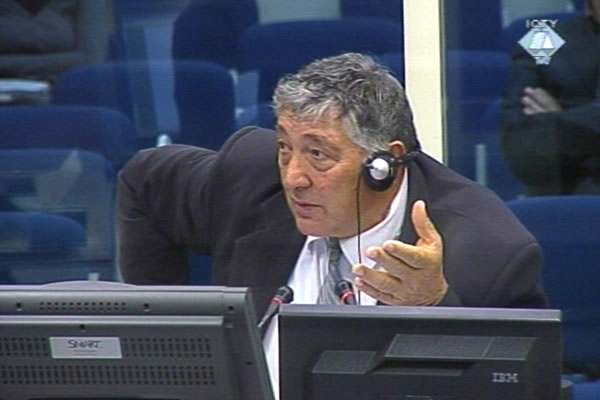Home
TV NEWS AS SOURCE FOR VRS INTELLIGENCE
Radovan Karadzic's defense witness claims that the VRS used footage shown by the Sarajevo TV to decide that the City Hall was used as a 'big ammunition depot'. The footage showed people carrying ammunition boxes and 'walking around the City Hall', Dusan Skrba said. The witness said he doubted that the fire in August 1992 could have been caused by VRS shells because the 'fire spread from the ground up, not from the roof down'
 Dusan Skrba, defence witness of Radovan Karadzic
Dusan Skrba, defence witness of Radovan Karadzic Dusan Skrba, war-time commander of the VRS Mixed Artillery Battalion in Lukavica, a neighborhood in Sarajevo, began his evidence in the defense of Radovan Karadzic last week and completed it today. The accused read out the summary of the witness's written statement in court and had no questions for the witness. Skrba's written statement was admitted into evidence.
In the statement, the witness claims the Sarajevo-Romanija Corps launched 'only defensive operations'. Fire was opened only in self-defense and on military targets according to detailed orders of the military command. The orders contained descriptions and dimensions of the target, location and details about the enemy forces. The witness and his subordinates 'always took measures not to open fire on civilian targets in the city', the statement notes. None of them 'ever intended to cause civilian casualties, to terrorize civilians or attack public transport vehicles', Skrba contends.
In the cross-examination, prosecutor Kimberly West referred to his statement that the shelling orders contained detailed specifications of military targets. Prosecutor West read the transcript of an intercepted communication of 29 May 1992. In the intercept, VRS officer Miso Potpara informed Ratko Mladic that his artillery had opened fire on the museum and hospital, in the direction of Crni Vrh. Mladic asked Potpara if he could 'fire on the railway station' and ordered him to 'hit them with something' and ‘chase off all that rabble around you’. The witness avoided giving a direct answer when the prosecutor asked him if this was detailed enough as a description of a target. The witness said it had nothing to do with him, but he wouldn't consider an order of this sort specific enough.
The National Library, located in the old City Hall building, was 'used as an ammunition depot', the witness claimed. According to the witness, this information came from the Sarajevo TV. TV news showed a 'large number of persons walking around the City Hall carrying ammunition boxes', the witness said. Skrba contends that the City Hall was not shelled from his artillery positions. He doubted that the City Hall had been shelled at all on 27 August 1992, because the fire had spread from the ground up and not from the roof down.
Skrba also said that from 1 July 1992, UN observers were constantly present at his command post and received regular reports on what his gunners were doing. UN observers never had any complaints about the reports. The prosecutor showed the witness the evidence of British lieutenant-colonel Richard Mole, senior UN military observer in Sarajevo, who claimed that the witness sometimes gave him 'trivial explanations' such as that fire had been opened from mortars just to 'warm up the barrels'. Mole termed the explanation 'unclear and irrational' and noted that in his opinion in that particular case there had been no specific target. When three round were fired on the city, Mole was told that it was ‘one [round] for each finger in the Serb salute'. The witness resolutely denied this and demanded to confront Mole.
After Dusan Skrbo ended his evidence, Karadzic called his next witness. Milos Skrbo is a former company commander in the 1st Sarajevo Motorized Brigade.
Linked Reports
- Case : Karadzic
- 2012-10-18 DENYING SNIPER AND ARTILLERY TERROR IN SARAJEVO
- 2012-10-17 KARADZIC 'AMENDS' WITNESS'S STATEMENTS
- 2012-10-17 DEMURENKO DENIES HE ENJOYED SPECIAL TREATMENT FROM VRS
- 2012-10-23 TARGETS OF MODIFIED AIR BOMBS
- 2012-10-23 DENYING SNIPER TERROR ATTACKS FROM SPICASTA STIJENA
- 2012-10-24 PAPOULIAS WILL NOT TESTIFY AT KARADZIC TRIAL
